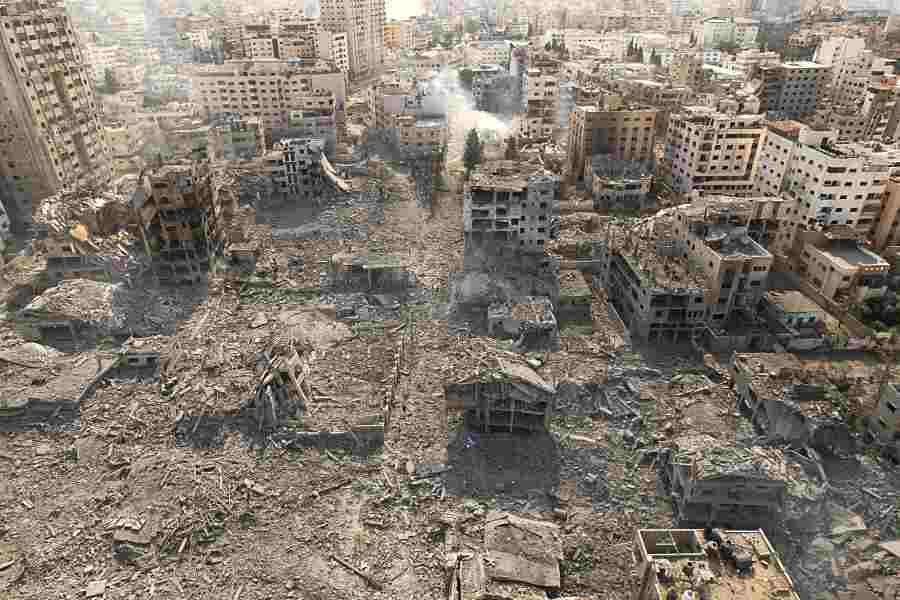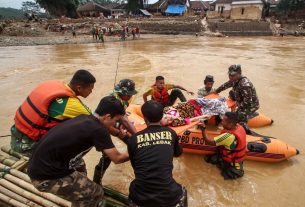Tue 08 October 2024:
– Head of Biodiversity and Sustainability Center at Bethlehem University tells Anadolu that some of environmental damage in region is now irreversible
ISTANBUL
Since Oct. 7, 2023, thousands of civilians have lost their lives in Gaza, where Israel has continued its attacks, turning the destruction caused by these assaults into ecocide.
In Israel’s attacks in Gaza, nearly 42,000 Palestinians were killed in one year, and nearly 100,000 were injured.
In addition to this humanitarian crisis, the attacks have caused ecocide by damaging agricultural lands, water resources, ecosystems, and biodiversity.
The term ecocide, used as an abbreviation for ecological destruction, is defined by the European Law Institute as “the destruction and devastation of the environment at any cost.”
The concept of ecocide was introduced by biology professor Arthur W. Galston during the Vietnam War in the 1970s and was frequently used in protests against the US military’s use of herbicides and Agent Orange to destroy the country’s vegetation and crops.
Ecocide is recognized as a crime under the category of war crimes in the Rome Statute, the founding treaty of the International Criminal Court, which defines attacks that cause wide, long-term, and serious damage to the natural environment in the context of war or conflict as criminal acts.
__________________________________________________________________________

https://whatsapp.com/channel/0029VaAtNxX8fewmiFmN7N22
__________________________________________________________________________
Traces of ecocide in Gaza
In the first four months of the attacks, Israel dropped 70,000 tons of bombs on the region, including phosphorus bombs, which are prohibited under the United Nations Convention on Certain Conventional Weapons (CCW), the government in Gaza announced.
In a photograph taken by Anadolu’s photojournalist Mustafa al-Kharouf on Oct. 9, 2023, M825 and M825A1 artillery shells, labeled D528, were clearly visible.
This label is used by the US Defense Department to refer to “white phosphorus-based munitions.”
According to the UN, munitions classified as incendiary weapons, including white phosphorus bombs, can cause significant damage to infrastructure and the environment.
Highly dangerous, white phosphorus ignites upon contact with air and cannot be extinguished as long as there is oxygen present.
When it comes into contact with water, white phosphorus can remain hidden for years and poisons aquatic life. It spreads through water sources into watersheds, and then into the soil and air.
When it comes into contact with plants, it kills them.
Destruction of agricultural lands in Gaza under heavy bombardment
According to the Damage Assessment of Agricultural Areas in the Gaza Strip report jointly published by the UN Institute for Training and Research (UNITAR) in collaboration with the European Organization for Nuclear Research (CERN) and the Food and Agriculture Organization (FAO) in June, agricultural productivity in Gaza has declined over time due to the ongoing war.
Various analyses conducted using images from the Sentinel-2 satellite taken in 2017 and 2024 examined the damage to trees and field crops.
The study concluded that bombings, damage caused by heavy vehicles, airstrikes, and other elements of conflict have severely impacted agricultural areas.
The agricultural land in the Gaza Strip covers approximately 150 square kilometers, which corresponds to 41% of the region.
Compared to the average of the previous seven years, a decrease in productivity was observed in 63% of the fields by June 2024.
Data obtained from satellite images dated June 18, 2024, indicated varying degrees of damage to agricultural areas in five main regions of the Gaza Strip.
In this context, approximately 75% of the agricultural land in northern Gaza, which is 31.3 square kilometers, suffered damage, translating to 23.5 square kilometers.
In Gaza City, out of 31.5 square kilometers of agricultural land, 69%, or 21.6 square kilometers, was affected.
In the Deir al-Balah region, 56% of the 25.9 square kilometers of agricultural land, or 14.6 square kilometers, was damaged. In the Khan Younis region, 58% of the 42.7 square kilometers of agricultural land, equivalent to 24.6 square kilometers, was affected, while in the Rafah region, 52% of the 19.1 square kilometers of agricultural land, or 9.9 square kilometers, were destroyed.
Satellite images of massive landfills
Following the attacks, the waste sorting infrastructure in the region has become unusable, turning waste into a serious public health issue.
According to a report titled War and Waste in Gaza, published by the Dutch NGO PAX for Peace in July, 225 waste sites where garbage has accumulated were identified between October 2023 and May 2024.
The report notes that this number includes waste sites large enough to be detected by satellite images, while many smaller waste sites also exist.
In addition, the incineration of waste contributes to air pollution and poses a risk of various infectious diseases.
Risk of loss in biodiversity
According to the Environmental Quality Authority affiliated with the Palestinian Authority, as of July 4, there are between 150 and 200 bird species, around 20 mammal species, and 20 rare and endangered reptile species in the region, while Israeli attacks are putting this biodiversity at risk.
Prof. Mazin Qumsiyeh, head of the Biodiversity and Sustainability Center at Bethlehem University, told Anadolu that some of the environmental damage in the region is now irreversible.
Urging that more studies should be conducted on this issue, Qumsiyeh said that the available research indicates that about 70% of the agricultural land in the region has been damaged.
He noted that the water aquifers in the region have suffered significant damage and may not recover; if they do, it could take decades.
He pointed out that there is no international legal authority to assess the ongoing ecological destruction, and due to the veto power held by certain countries in the UN Security Council, these crimes remain unpunished.
“The Zionist regime is therefore above the law and has engaged in genocide, ecological genocide, and scholastic genocide,” he said.
Qumsiyeh underlined the need for greater public awareness to make this issue more visible and to strengthen reactions through measures such as boycotts and sanctions.
He pointed out that the humanitarian crisis in Gaza is not just regional but global, posing a threat to world peace.
SOURCE: INDEPENDENT PRESS AND NEWS AGENCIES
______________________________________________________________
FOLLOW INDEPENDENT PRESS:
WhatsApp CHANNEL
https://whatsapp.com/channel/0029VaAtNxX8fewmiFmN7N22
![]()
TWITTER (CLICK HERE)
https://twitter.com/IpIndependent
FACEBOOK (CLICK HERE)
https://web.facebook.com/ipindependent
YOUTUBE (CLICK HERE)
https://www.youtube.com/@ipindependent
Think your friends would be interested? Share this story!





